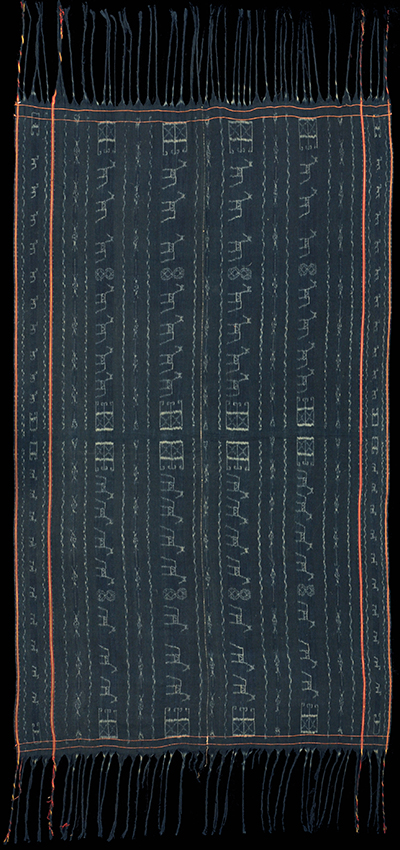| |
 
 | | | |
116 Flores Group, Ngadha
Lue (blanket)  
| | Locale: | Probably Lopi Jo. | | Period: | 19th to early 20th c. | | Yarn: | Cotton, hand-spun, fine | | Technique: | Warp ikat | | Panels: | 2 | | Size: | 120.5 x 202 cm (3' 11" x 6' 7") LW: 1.68 | | Weight: | 690 g (24.3 oz), 283 g/m2 (0.93 oz/ft2) | | Design: | Lue jara of a type known as kain kudu, 'horse cloth', with motif for high-ranking man: fifty-six white, angular horses (jara) on indigo background. Some additional geometrical ornamentation and rows of smaller horses along longitudinal borders. Four narrow accent stripes in red end yellow. Note the asymmetry, the small motifs on either side of the seam are different. Other details as well - such as the placement of the lozenges on the first ikated band of the midfield, which are not spaced equally - prove that no replication took place. As such cloths were always made with a circular warp, creating two identical panels at the same time, it is almost certain that a twin cloth was created in parallel. | | Comment: | Ngadha shawl, lue jara, for nobleman of the class that can afford a feast involving buffalo slaughter. Piece of rare quality with attractive, primitive design. Very good weaving, well above common Bajawa standards. Beautiful indigo tone. Fine hand spun, accent stripes in benang toko. The white is actually pale blue, due to the Ngada practice of repeated steeping in the indigo bath for such long periods that some seepage of dye into the tied parts of the yarn occurs. | | Background: | Chapters on Flores Group and Ngadha. | | Exhibited: | Museu do Oriente, Lisbon, 2014/15 | | Published: |
Woven Languages, 2014.
Ikat Textiles of the Indonesian Archipelago, 2018.
| | Compare: | 076 | | Sources: | Near-identical 19th C. lue in Granucci, Art of the Lesser Sundas, Fig. 101. Another near-identical cloth in Khan Majlis, Woven Messages, Fig. 162. Similar lue in Yoshimoto, Ikat, Fig. 109. Similar motif on Ngadha sarong in Gisela Voelger c.s., Indonesian Textiles, Supplement by Khan Majlis, Fig. 125, and on Pusaka Collection Nr. 076. See also Roy Hamilton, Gift of the Cotton Maiden, p.104-105, and Fig. 5-16. Very similar also to cloth identified as seda in NGA, 1984.3188, depicted in Maxwell, Textiles of Southeast Asia, Fig. 150. | | |

©Peter ten Hoopen, 2025
All rights reserved.
|
|


